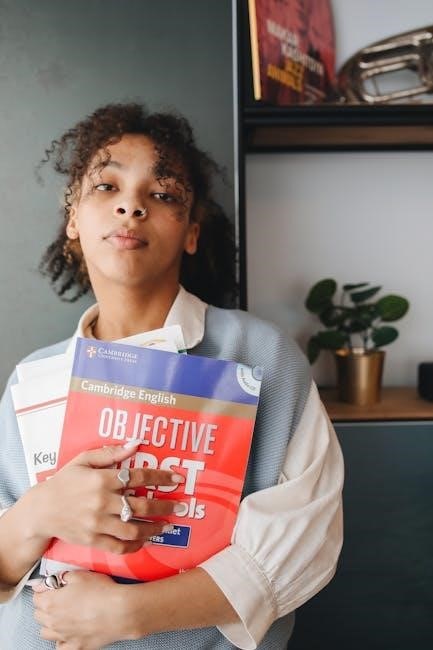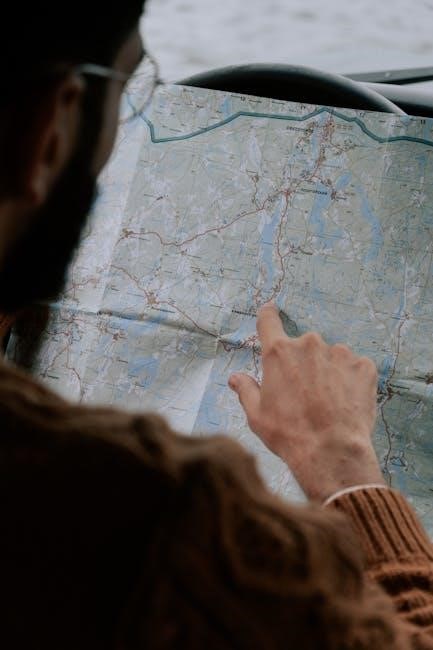Photography is an art form that captures life’s moments through light, composition, and technique. Understanding the fundamentals, like exposure and camera settings, will help you take stunning photos.
1.1 Understanding the Exposure Triangle
The Exposure Triangle—aperture, shutter speed, and ISO—forms the foundation of photography. Aperture regulates light entry, shutter speed captures motion, and ISO adjusts sensitivity. Balancing these elements ensures well-exposed photos. Mastering this relationship is crucial for achieving desired effects, whether freezing action or creating depth of field. Experiment with these settings to understand how they interact and enhance your images effectively.
1.2 Essential Camera Settings for Beginners
Mastering basic camera settings is key for improving your photography. Start with modes like Auto or Manual to gain control. Clean your lens regularly to avoid blurry shots. Hold the camera steady or use a tripod to prevent shake. Experiment with settings like autofocus and white balance to enhance clarity and color accuracy; These simple adjustments will help you capture sharper, more vibrant images with ease and confidence.
Mastering Photography Composition
Composition is key to making photos visually appealing. It involves arranging elements like balance, leading lines, and framing to create engaging and harmonious images that tell a story.
2.1 The Rule of Thirds
The Rule of Thirds is a fundamental composition technique where images are divided into thirds both vertically and horizontally, creating nine equal parts. Important elements should be placed along these lines or at their intersections, rather than centering the subject. This method creates balance, makes photos more dynamic, and guides the viewer’s eye naturally. Avoid centering subjects unless simplicity is the goal. Experiment to see how it enhances your shots and adds visual interest.
2.2 Leading Lines and Framing
Leading lines guide the viewer’s eye to the subject, creating a sense of direction and depth. Use natural features like roads, shorelines, or patterns to draw attention to your focal point. Framing involves using elements like archways or trees to enclose your subject, adding context and depth. Experiment with these techniques to enhance composition and make your photos more engaging and professional-looking, ensuring your subject stands out effectively.
Best Practices for Lighting
Lighting is a cornerstone of photography. Shoot during the golden hour or under cloudy skies for soft, diffused light. Avoid harsh midday sun for better results. Clean your lens to ensure clarity in your photos.
3.1 Shooting During the Golden Hour
Shooting during the golden hour offers soft, warm light ideal for portraits and landscapes. This period, shortly after sunrise or before sunset, reduces harsh shadows and enhances colors. Plan your shots in advance and use a tripod for stability. The golden hour’s magical light creates captivating images with minimal effort.
3.2 Utilizing Cloudy and Diffused Light
Cloudy skies provide soft, diffused light ideal for vibrant colors and even illumination. This lighting minimizes harsh shadows, making it perfect for capturing details in both bright and dark areas. Use cloudy conditions for portraits, as it creates flattering, natural-looking skin tones. Diffused light also enhances textures in landscapes and reduces overexposure, ensuring balanced and professional-looking photos with minimal effort.

Tips for Sharp and Clear Photos
Sharp photos require a steady hand and clean lens. Avoid blur by holding your camera firmly, especially in low light or zoomed shots, ensuring crisp, detailed images.
4.1 Avoiding Blur by Holding the Camera Steady
Avoiding blur is essential for sharp photos. Hold the camera firmly with both hands, one gripping the body and the other supporting the lens. Tuck your elbows close to your body for stability. Shaky hands often cause blur, especially in low light or when zoomed in. Use a tripod if needed. A steady camera ensures crisp, detailed images, capturing every moment with clarity and precision, free from unwanted blur.
4.2 The Importance of Cleaning Your Lens
Cleaning your lens is crucial for clear, vibrant photos. A dirty lens can cause blurry or foggy images, ruining otherwise perfect shots. Use a soft, microfiber cloth to gently wipe away smudges and fingerprints. Avoid harsh chemicals or abrasive materials that might scratch the glass. Regular cleaning ensures sharp details and accurate colors, enhancing overall image quality and helping you capture life’s moments with clarity and precision.

Advanced Techniques for Creative Photography
Explore creative photography by experimenting with patterns, perspectives, and depth. These techniques add unique visual interest and storytelling elements to your images, enhancing their artistic impact.
5.1 Experimenting with Patterns and Perspectives
Experimenting with patterns and perspectives adds depth and interest to your photos. Look for symmetry, textures, or repeating shapes in nature and architecture. Unique viewpoints, like shooting from low or high angles, can transform ordinary scenes into extraordinary ones. This creative approach challenges your eye and inspires fresh ways to frame your world, making your images more engaging and thought-provoking for viewers.
5.2 Building Depth in Your Images
Building depth in your photos creates a three-dimensional feel, engaging viewers by guiding their eyes through the scene. Use leading lines, framing, and layering to achieve this. Incorporate foreground, middle ground, and background elements to add complexity. Experiment with angles and focus to emphasize subjects while blurring less important areas. This technique enhances storytelling and makes images more dynamic and visually appealing, drawing viewers into the frame.
Specialized Photography Guides
Explore expert tips for capturing stunning travel photos, mastering firework and waterfall shots, and understanding passport photo guidelines for professional results in specialized photography scenarios.
6.1 Capturing Stunning Travel Photos
To elevate your travel photography, step away from iconic spots and capture unique perspectives. Experiment with angles, lighting, and compositions. Focus on details like textures, patterns, and local culture. Engage with locals to gain authentic insights. Avoid clichés and embrace spontaneity. Use a tripod for low-light situations and consider drone photography for breathtaking vistas. Plan your shots during golden hours for magical light. Keep your gear minimal and stay curious to tell compelling visual stories.
6.2 Tips for Photographing Fireworks and Waterfalls
For fireworks, use a tripod and remote shutter release to avoid blur. Shoot in RAW for better editing and use a wide-angle lens to capture the entire display. Focus on bursts and experiment with slow shutter speeds for creative effects. For waterfalls, use a polarizing filter to reduce glare and enhance colors. Shoot during overcast skies for softer light and try slow shutter speeds to create a misty, ethereal effect.

Smartphone Photography Hacks
Use volume buttons for shutter release to avoid shake, clean your lens regularly, and shoot during golden hour for stunning natural light and vibrant colors.
7.1 How to Take RAW Photos on iPhone
Enable RAW format in your iPhone’s settings under the ProRAW option for higher quality images. Use third-party apps like Adobe Lightroom for editing RAW files to enhance details and colors, ensuring professional-grade results with greater flexibility in post-processing.
7.2 Using Google Photos for Image Management
Google Photos is an excellent tool for organizing, storing, and editing your photos. It offers automatic backup, AI-powered tagging, and shared albums. Use its built-in editing tools to enhance images and create stunning visuals. The platform also supports RAW files, allowing you to maintain high quality while managing your photo library efficiently. It’s a great solution for both casual and professional photographers seeking seamless image management.

Professional Photography Insights
Professional photography combines technical mastery with artistic vision, focusing on lighting, composition, and storytelling. It requires precision and creativity to capture polished, high-quality images that resonate emotionally.
8.1 The Role of Lighting in Professional Portraits
Lighting is the cornerstone of professional portrait photography, shaping depth, contrast, and mood. Natural light during the Golden Hour offers soft, flattering tones, while cloudy days provide diffused illumination for vibrant colors. Avoid harsh midday sun, as it creates unflattering shadows. Proper lighting enhances facial features, creating a polished, professional look that captures the subject’s essence and emotion effectively in every frame.
8.2 Post-Production Tricks for Enhancing Photos
Post-production is crucial for enhancing photos. Use tools like Google Photos or professional software to adjust exposure, contrast, and colors. Cropping and noise reduction can refine your images. Experiment with filters and presets for a polished look. Always edit in RAW format for better quality and non-destructive changes. These tricks ensure your photos stand out, making them ready for sharing or printing with professional-grade results.
Photography for Specific Purposes
Photography serves various purposes, from capturing passport photos to documenting travel adventures and low-light moments. Each requires specific techniques to achieve the desired results effectively and professionally.
9.1 Passport Photo Guidelines
Passport photos require a plain background, neutral expression, and proper lighting. Ensure the face is centered, with eyes open and visible. Use a recent photo that meets size and format specifications. Avoid shadows or reflections. Check local regulations for additional requirements, as guidelines vary by country. Properly formatted photos ensure a smooth application process and avoid delays. Always verify the latest requirements before submitting your application.
9.2 Tips for Taking Photos in Low-Light Conditions
Low-light photography can be challenging, but using a tripod or stabilizing your camera helps prevent blur. Adjust ISO settings carefully to avoid noise. Shoot in RAW format for better editing flexibility. Utilize natural light sources or reflectors to enhance illumination. Avoid overusing flash, as it can create harsh shadows. Experiment with slower shutter speeds for creative effects. Practice and patience are key to capturing sharp, well-lit images in dim conditions.
Photography is a journey of learning and creativity. This guide covers essential techniques. Build a portfolio, keep practicing, and experiment to capture stunning images consistently.
10.1 Building a Photography Portfolio
Creating a photography portfolio is essential for showcasing your skills and style. Include your best work, demonstrating versatility in composition, lighting, and storytelling. Use platforms like Format to display your images professionally. Regularly update your portfolio with fresh, high-quality photos that reflect your growth. Experiment with different themes and styles to highlight your unique perspective. A strong portfolio is a powerful tool for attracting opportunities and feedback.
10.2 Continuous Learning and Improvement
Continuous learning is key to mastering photography. Experiment with new techniques, stay updated with trends, and seek feedback from peers. Practice regularly to refine your skills and adapt to challenges. Engage in online tutorials and workshops to explore advanced methods. Learning is a lifelong journey; embrace it to evolve your style and capture stunning images that reflect your artistic growth and technical mastery.
